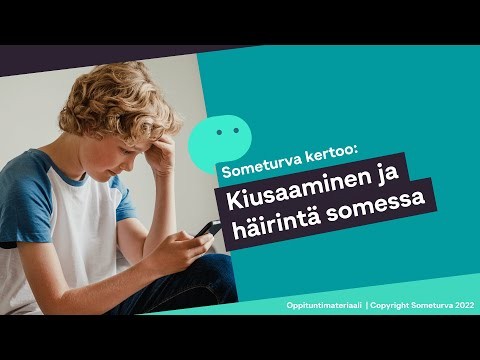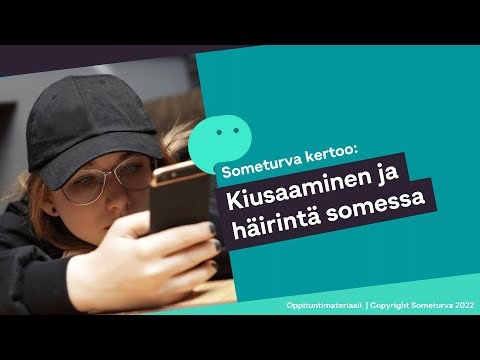Lesson materials on harassment and bullying on social media
On this page you will find Someturva's lesson materials for schools.

Someturva is a digital service developed by experts, through which you can anonymously request help for unpleasant situations encountered on social media, games or other online platforms. Someturva is used in several Finnish municipalities, such as Vantaa, Espoo and many others. Someturva's expert team, which consists of lawyers, social psychologists and psychologists, has already helped to solve thousands of difficult situations.
Someturva's materials are lesson plans for different age groups created by experts specialised in bullying and harassment on social media. In the materials, the topic is introduced and presented in a practical way together with the case examples. Each lesson plan consists of a video and a teacher's guide in a pdf format.
If you have any questions about the materials, kindly send us a message in the chat that you can find at the bottom corner of the page or contact us using the form on this website.
The lessons and the curriculum of basic education
The lessons can be implemented, for example, as a part of the interdisciplinary learning modules.
The lessons support fulfilling the aims set for transversal skills and competences:
- Thinking and learning to learn (L1)
- Cultural competence, interaction and self-expression (L2)
- Taking care of oneself and managing daily life (L3)
- Multiliteracy (L4)
- ICT competence (L5)
- Working life competence and entrepreneurship (L6)
- Participation, involvement and building a sustainable future (L7)

Grades 1-2
Quick guide: Material that leaves you thinking
This lesson material is well suited for even the youngest pupils in primary school. The lesson will cover the types of content they might encounter online and why it's important not to share unpleasant or disturbing material.
The lesson consists of three case examples and tasks that can be used in the classroom (provided as a PDF).
The duration of the lesson is 45 minutes.
Quick guide: Strange messages from strangers
Lesson material that is also well-suited for the youngest pupils in primary school. During the lesson, pupils get to consider how to act if they receive unpleasant or strange messages from strangers in games, online, or via phone.
The lesson consists of three case examples and classroom activities (pdf).
Lesson duration: 45 minutes.
Quick guide: Why is it important to tell an adult?
This lesson material is well suited for even the youngest students in the comprehensive school. During the lesson, students will get to consider in which situations it's important to tell an adult and why it can sometimes feel difficult to do so.
The lesson consists of two case examples and classroom activities (pdf).
Lesson duration: 45 minutes.
Grades 3-6
Quick guide: Grooming
The lesson covers the phenomenon of grooming. With the help of this lesson, the students will learn how to recognise when it is wrong for adults to message children on social media. The lesson material will also cover ways to protect yourself from inappropriate contacts on social media. The lesson consists of a video with a case example and short information on the subject, as well as a discussion task to be used in class (pdf). The duration of the lesson is 45 min.
Quick guide: Taking photos and sharing them online
The lesson is about taking and sharing photos. The lesson will help students to learn why and in what situations it is wrong to take photos and share photos or videos on social media. The lesson will also cover what to do if someone shares a photo or video of you or your classmate without permission. The lesson consists of a video with a case example and some information on the subject, as well as discussion tasks to be used in class (pdf).
Quick guide: Shocking content
This lesson addresses the issue of encountering and sharing shocking content online. During the lesson the pupils will get information on why some people share shocking material and why it is wrong to do so. Additionally, the lesson covers what to do if you come across shocking content online or if you are added to a group where disturbing material is shared.
The lesson includes a video with a case example and a quick guide on the topic, along with discussion tasks that can be used in the classroom (provided as a PDF).
The duration of the lesson is 45 minutes.
Quick guide: Threats online and in games
The lesson addresses threats that occur on social media, online, and in games. During the lesson, students will learn why threats are harmful and what consequences threats can have for the person making them. Additionally, the lesson covers what to do if you are personally targeted by threats.
The lesson includes a video with a case example and information on the topic, as well as discussion tasks that can be used in the classroom (pdf).
The lesson duration is 45 minutes.
Quick guide: Fake profiles
The lesson explores what fake profiles are and why impersonating someone online is wrong. During the lesson, there is also discussion about what personal information is, why one must not use someone else's personal information without permission, and how to act if one becomes a target of a fake profile.
The lesson includes a video with a case example and information on the topic, as well as discussion exercises for classroom use (pdf).
Lesson duration: 45 minutes.
Quick guide: Do you recognize what is true?
The lesson explores why lies and rumors are spread on social media and how to identify what is true and what is not.
The lesson includes a video with a case example and information on the topic, as well as classroom discussion activities (pdf).
Lesson duration: 45 minutes.
Grades 7-9
Quick guide: Nude photos
The lesson goes over why nude photos may not be shared online without permission. The lesson also explains when it is a crime to forward or share the photos to others.
The lesson consists of a video with a case example and some information on the subject, as well as the discussion tasks to be used in class (pdf). The duration of the lesson is 45 min.
Quick guide: Fake profiles
The lesson will discuss the phenomenon of fake profiles, and why fake creating profiles is wrong and can even be a crime. The lesson will also cover what to do if a fake profile has been created about you or your friend. The lesson consists of a video with a case example and some information on the subject, as well as discussion tasks to be used in class (pdf).
Quick guide: Are you allowed to film someone without permission?
This lesson covers in which situations and places it is permissible to take photographs, and in which it is not. The lesson also discusses what actions to take if an unpleasant photo or video of oneself is shared on social media.
The lesson includes a video with a case example and a quick guide on the topic, along with discussion tasks that can be used in the classroom (provided as a PDF).
The duration of the lesson is 45 minutes.
Quick guide: Spreading rumors and lies
The lesson addresses the spread of rumors and lies on social media. During the lesson, students will reflect on why lies and rumors spread quickly online and why rumors spread on social media can be harmful. The lesson also covers what to do if rumors or lies are spread about you or a friend on social media.
The lesson includes a video with a case example and information on the topic, as well as discussion tasks that can be used in the classroom (pdf).
The lesson duration is 45 minutes.
Quick guide: Isulting comments
The lesson addresses the sharing of insulting and provocative comments on social media. Pupils get to consider why some people write provocative comments and what consequences anonymous comments might have. The lesson also covers what can be done if one regrets comments they have written.
The lesson includes a video with a case example and information on the topic, as well as classroom discussion activities (pdf).
Lesson duration: 45 minutes.
Quick guide: How do algorithms affect you?
The lesson covers recommendation algorithms and how they can influence our opinions and actions. In the lesson, students will get to think about how recommendation algorithms work and how to be in control of their social media use.
The lesson includes a video with a case example and information on the topic, as well as classroom discussion activities (pdf).
Lesson duration: 45 minutes.
Upper secondary level
Quick guide: Nude photos
The lesson goes over why nude photos may not be shared online without permission. The lesson also explains when it is a crime to forward or share these photos to others.
The lesson consists of a video with a case example and some information on the subject, as well as the discussion tasks to be used in class (pdf). The duration of the lesson is 45 min.
Quick guide: Fake profiles
The lesson will discuss the phenomenon of fake profiles, and why fake creating profiles is wrong and can even be a crime. The lesson will also cover what to do if a fake profile has been created about you or your friend. The lesson consists of a video with a case example and some information on the subject, as well as discussion tasks to be used in class (pdf).
Quick guide: Are you allowed to film someone without permission?
This lesson covers in which situations and places it is permissible to take photographs, and in which it is not. The lesson also discusses what actions to take if an unpleasant photo or video of oneself is shared on social media.
The lesson includes a video with a case example and a quick guide on the topic, along with discussion tasks that can be used in the classroom (provided as a PDF).
The duration of the lesson is 45 minutes.
True crime: Instagram riot in Gothenburg
Someturva's first True Crime video covers a real incident where a rumor account about young people in a city led to punishments and large compensations for the damages. During the lesson, students will reflect on how spreading rumors on social media can be a crime and what consequences it can have. The lesson also discusses what to do if rumors or lies are spread about oneself or a friend on social media.
The lesson includes a video in which a Someturva expert reviews the case, as well as discussion tasks that can be used in the classroom (pdf).
The lesson duration is 20-45 minutes.
True crime: Deep fake scandal in Spain
This lesson deals with a real-life event, in which AI-generated nude images grew into a scandal in Spain and eventually led to criminal convictions. With the help of the video, students can explore what online crime can look like and what consequences it can have. The students can also consider how to act in similar situations and where to get help.
The lesson includes a video in which a Someturva expert reviews the case, as well as discussion tasks that can be used in the classroom (pdf).
The lesson duration is 20-45 minutes.
Other videos and materials
How do I log in to Someturva and how does it work?
Watch the video for instructions on how to start using Someturva. How do you activate a user account and how do you log in to the service?
I want Someturva's school-related news and updates on bullying and harassment in social media.
Get in touch
Office
- Chat
- Open a chat
- info@someturva.fi
- Phone number
- +358505053134

























